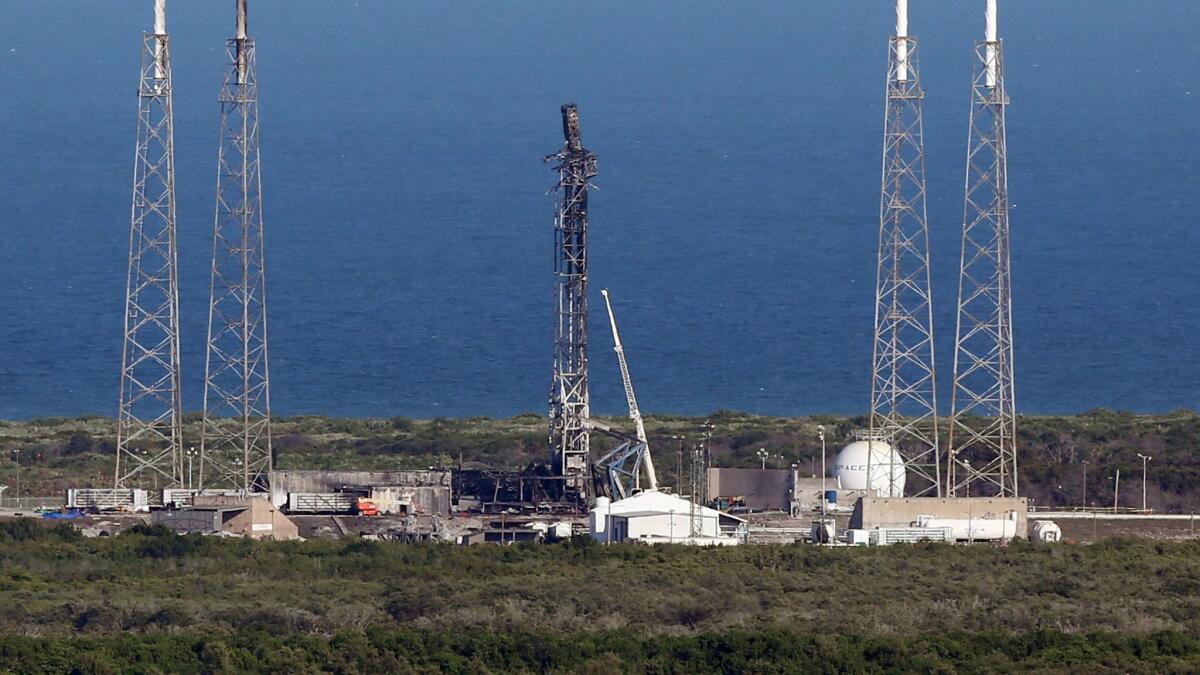SpaceX eyes Jan. 8 return to satellite launches after finishing explosion investigation

The SpaceX launch complex at Cape Canaveral Air Force Station in Florida was damaged after a Falcon 9 rocket exploded in September.
SpaceX is now targeting Jan. 8 for its return to flight after completing its investigation of a September launch pad explosion that destroyed a Falcon 9 rocket and a commercial communications satellite.
Pending approval from the Federal Aviation Administration, the Hawthorne space company plans to launch 10 satellites on one Falcon 9 rocket for Iridium Communications Inc. from Vandenberg Air Force Base. The satellites will be part of Iridium’s new satellite constellation to provide mobile communications capabilities on land and on ships and airplanes.
On Monday, Iridium tweeted that it was “pleased with SpaceX’s announcement and targeted launch date.”
The news comes after a four-month-long investigation that even company Chief Executive Elon Musk described in November as “the toughest puzzle to solve that we’ve ever had to solve.”
A few weeks after the explosion, SpaceX said it expected to return to flight as soon as November. But as the investigation continued, that anticipated launch date slipped back to December, and then January.
“Clearly, they’re being extra cautious,” said Marco Caceres, senior space analyst for the Teal Group. “SpaceX usually pushes ahead a lot faster, so it seems like they’re not rushing ahead at this point, which is a good thing.”
The Sept. 1 explosion at Cape Canaveral Air Force Station destroyed a satellite that was to be managed by Israeli satellite operator Spacecom and was also to help Facebook Chief Executive Mark Zuckerberg bring high-speed Internet access to remote parts of Africa.
In the final update released Monday, SpaceX said it pored through 3,000 channels of video and telemetry data that spanned just 93 milliseconds from the first sign of trouble to the explosion.
The company said one of three composite overwrapped pressure vessels, or tanks, inside the rocket’s larger, second-stage liquid oxygen tank failed, probably after a buildup of liquid oxygen between the vessel’s aluminum inner liner and its carbon overwrap ignited.
The vessels are used to store cold helium that maintains pressure in the liquid oxygen tank. As the liquid oxygen depletes, the helium helps fill the void.
SpaceX said its accident investigation team found “buckles,” or valleys, in the vessels’ inner liners.
Super-chilled liquid oxygen can gather there, and when pressurized, the oxygen can get trapped. Then, “breaking fibers or friction can ignite the oxygen in the overwrap,” causing the vessel to fail, SpaceX said.
The company also said the loading temperature of the helium was cold enough to create solid oxygen, “which exacerbates the possibility of oxygen becoming trapped as well as the likelihood of friction ignition.”
In its statement, SpaceX said the investigation team found “several credible causes” for the vessel’s failure, all of which involved the accumulation of oxygen in the buckles.
To fix this issue in the short term, SpaceX said it will change the configuration of the composite overwrapped pressure vessels so warmer helium can be loaded.
It will also change helium loading operations to a “prior flight proven configuration” that is based on previous successful procedures.
SpaceX plans to eventually change the design of the vessels to prevent buckles, which the company said will allow for faster loading operations in the future.
If the FAA gives approval and grants SpaceX the customary launch license, “that’s a pretty good indication that the failure report is indeed convincing, and independent people responsible for safety are convinced that SpaceX knows what happened and is taking the right remedial steps,” said John Logsdon, professor emeritus at the Space Policy Institute at George Washington University.
After that, it is “crucial” that SpaceX has a series of successful launches, he said.
“A lot of users of space have been willing to depend on them,” Logsdon said. “And I think they have to demonstrate that they earned or re-earned that confidence.”
Musk had previously hinted at the cause of the explosion in an interview on CNBC in November, saying the culprit involved a combination of liquid helium, carbon fiber composites and solid oxygen.
The investigation was led by SpaceX, with assistance from NASA, the U.S. Air Force, the National Transportation Safety Board and several industry experts, under FAA oversight.
Under federal law, SpaceX is allowed to conduct its own investigation. SpaceX, whose full name is Space Exploration Technologies Corp., and other companies lobbied successfully to extend the law in 2015. The FAA oversees such investigations.
Sunday’s launch will be “all-important” for the company, Caceres said.
Not only does SpaceX have a long manifest of launch customers, including NASA supply missions to the International Space Station, but it is also building a crew capsule to ferry astronauts to the space station.
That capsule is set for its first uncrewed flight test in November, followed by its first flight test with humans in May 2018.
SpaceX also plans to launch its heavy-lift rocket, the Falcon Heavy, this year for the first time. The company has said the rocket will be able to lift off from either Vandenberg or Pad 39A, SpaceX’s alternate launch pad at Kennedy Space Center, which is close to being operational and will also be able to launch Falcon 9 rockets.
Work on Space Launch Complex 40, which was damaged during the explosion, still continues.
“SpaceX is the establishment player,” Caceres said. “As the establishment player, I think they have something to lose.”
For more business news, follow me @smasunaga
ALSO
Elon Musk describes his vision for human habitats on Mars
What it’s like wearing Snapchat Spectacles
An Indian billionaire says his new tech company is growing faster than Facebook and Whatsapp
UPDATES:
2:10 p.m.: This article was updated throughout with information about the explosion and comments from analysts.
This article was originally published at 6:05 a.m.
More to Read
Inside the business of entertainment
The Wide Shot brings you news, analysis and insights on everything from streaming wars to production — and what it all means for the future.
You may occasionally receive promotional content from the Los Angeles Times.










